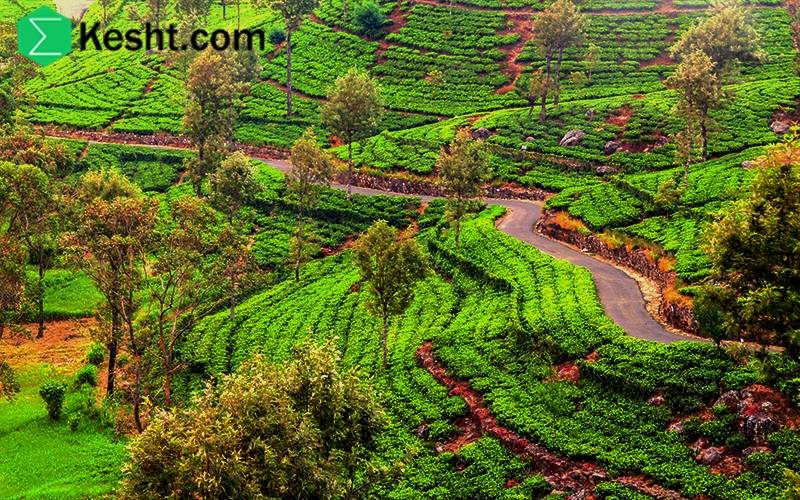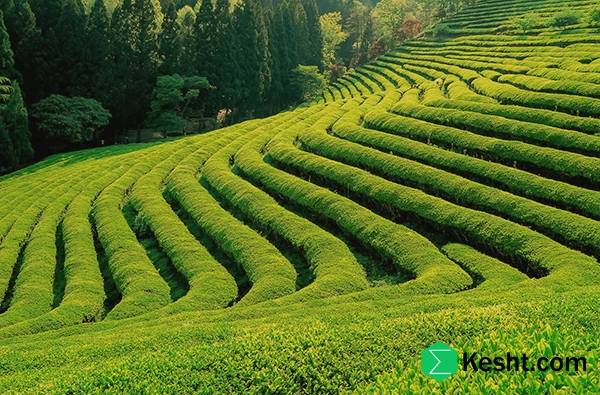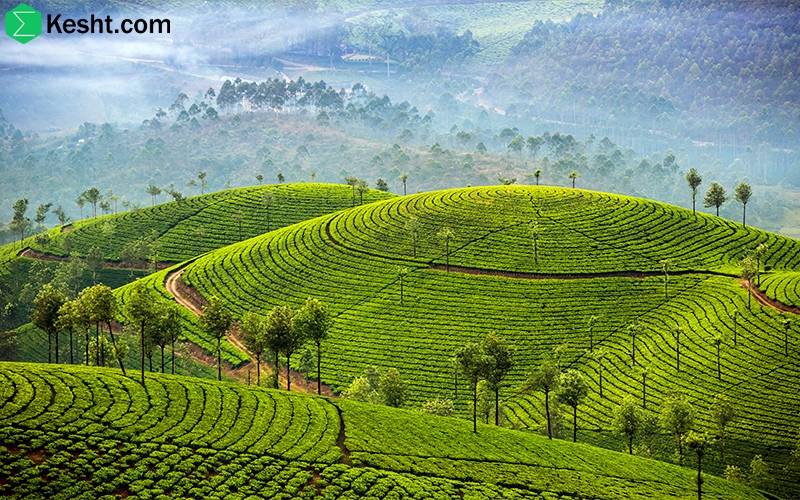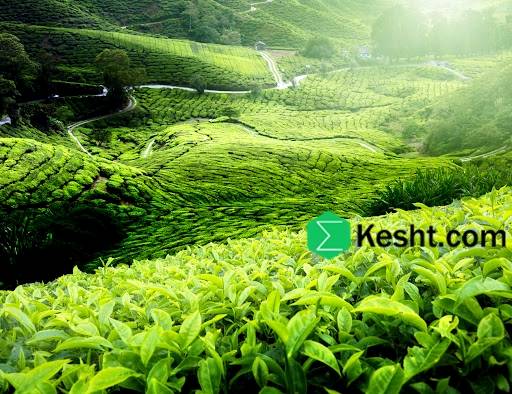The difference between Iranian tea and foreign teas, such as those grown in China, India, and Kenya, depends on various factors, including climatic conditions, soil type, and climates. Below, I will examine these differences in a specialized and scientific manner:
Climatic Conditions
Iranian Tea (Gilan and Mazandaran):
Climate: The northern regions of Iran have a humid and temperate climate. High precipitation and relatively mild temperatures throughout the year contribute to tea growth.
Effect on Flavor: The high humidity and mild temperatures result in tea with a gentle and pleasant aroma and flavor.
Chinese Tea:
Climate: China has a wide variety of climates, ranging from tropical to temperate.
Effect on Flavor: This diversity leads to the production of various teas with distinct flavors, including green tea, black tea, and oolong tea.
Indian Tea:
Climate: Tea is typically grown in elevated and tropical regions of India. High temperatures and suitable humidity help produce strong and fragrant teas.
Effect on Flavor: Indian teas, such as Darjeeling and Assam, are known for their strong flavors and unique aromas.
Kenyan Tea: Grown in warm and humid regions, it is recognized as one of the major producers of tea with a strong flavor.
The differences between Iranian tea and foreign teas depend on climatic conditions, soil types, and various climates. These factors create distinct flavors and aromas in the teas, with each type having its unique characteristics.
The Impact of Altitude on the Flavor and Quality of Tea in Different Regions
Altitude is a key factor in tea production and significantly affects its flavor and quality. Here’s an examination of the impact of altitude on tea in various regions:
Impact on Plant Growth
Slower Growth: At higher altitudes, temperatures are generally lower, resulting in slower plant growth. This can lead to the production of higher-quality leaves with richer aromas and flavors.
Harvest Timing: Plants at high altitudes are usually harvested later than those at lower altitudes.
Impact on Flavor
Richer Aroma and Flavor: Increased altitude typically leads to higher concentrations of aromatic compounds such as flavonoids and antioxidants. These compounds contribute to the flavor and aroma of the tea.
Softer Taste: Teas grown at high altitudes usually have a milder and more pleasant taste due to slower growth and more time for the plants to absorb nutrients.
Impact on Quality
Higher Quality: Teas grown at high altitudes generally have higher quality and are used to produce luxurious and expensive teas. For example, Indian Darjeeling tea, grown at high altitudes, is known for its unique quality and flavor.
Flavor Diversity: Teas grown at different altitudes typically have more diverse flavors, resulting from variations in environmental conditions and nutrients available in the soil.
Practical Examples
Darjeeling Tea (India): This tea is grown at altitudes above 1,000 meters and is famous for its mild flavor and unique aroma.
Kenyan Tea: Typically grown at lower altitudes, it has a strong and robust flavor due to warmer climatic conditions and high humidity.
Altitude significantly affects the flavor and quality of tea. Teas grown at high altitudes usually have better quality and taste due to suitable growth conditions and high concentrations of aromatic compounds. This contributes to the production of luxurious and popular teas.
How Does the Relationship Between Soil Type and Altitude Affect Tea Quality?
The relationship between soil type and altitude on tea quality is quite complex, and these two factors jointly influence the characteristics of tea. Here’s an examination of this relationship:
Impact of Altitude on Soil Characteristics
Fertile Soils: At higher altitudes, soils are usually more fertile. These soils contain more nutrients due to higher rainfall and less erosion, which are essential for the growth of tea plants.
Water Availability: At higher altitudes, water is typically more accessible, aiding the better growth of roots and nutrient absorption.
Impact of Soil Type on Tea Quality
Mineral Compounds: Soil type can influence the mineral compounds present in tea. For example, iron- and calcium-rich soils can enhance the flavor and aroma of the tea.
Soil pH: The pH of the soil also affects tea quality. Acidic soils are generally more suitable for tea cultivation and help produce tea with a milder flavor.
Combined Impact of Altitude and Soil Type
Positive Interaction: At high altitudes with fertile soils, tea usually has better quality and flavor. These conditions allow the plant to effectively utilize nutrients and produce more aromatic compounds.
Impact on Flavor and Aroma: The combination of altitude and soil type can lead to the production of tea with diverse flavors and rich aromas. Tea grown in high-altitude areas with suitable soils typically has higher quality due to the high concentration of flavonoids and antioxidants.
Altitude and soil type jointly influence tea quality. Fertile soils at high altitudes provide an ideal environment for tea plant growth, resulting in tea with rich flavor, aroma, and high quality. Choosing suitable locations for tea cultivation based on these factors can significantly impact tea production success.
How Does the Type of Fertilizer Affect Tea Quality at Different Altitudes?
The impact of fertilizer type on tea quality at various altitudes depends on several factors and can significantly affect plant growth, flavor, and tea quality. Here’s an examination of these effects:
Nutritional Needs of the Tea Plant
Nutrients: The tea plant requires several types of nutrients, including nitrogen, phosphorus, potassium, and micronutrients such as iron and manganese. The type of fertilizer chosen can greatly influence the supply of these nutrients.
Impact of Altitude on Fertilizer Effects
High Altitudes: At high altitudes, climatic conditions are usually cooler and wetter. In these areas, plants may require more nutrients to grow in variable conditions. The use of organic and mineral fertilizers can help improve the quality and flavor of tea.
Low Altitudes: At lower altitudes, temperatures are generally higher, and plants may grow faster. In these conditions, the use of balanced fertilizers can promote healthy growth and the production of quality leaves.
Type of Fertilizer and Its Impact on Quality
Organic Fertilizers: These fertilizers typically include compost, manure, and other natural materials. The use of organic fertilizers can improve soil structure, enhance soil microbiology, and provide sustainable nutrients. This leads to the production of tea with better flavor and aroma.
Chemical Fertilizers: These fertilizers usually act more quickly and can help provide nutrients rapidly. However, excessive use may lead to chemical buildup in the soil and negatively impact tea quality.
Impact on Flavor and Aroma
Production of Aromatic Compounds: The type of fertilizer can influence the production of aromatic and flavor compounds in tea. For example, organic fertilizers can aid in the production of flavonoids and antioxidants that contribute to the flavor and aroma of tea.
Soil pH Regulation: Some fertilizers can alter soil pH, which in turn affects nutrient absorption and tea quality.
The type of fertilizer significantly impacts tea quality at different altitudes. At high altitudes, the use of suitable organic and mineral fertilizers can promote healthy growth and rich flavor and aroma production. At lower altitudes, balanced fertilizer use is also essential for maintaining tea quality and flavor. Choosing the appropriate type of fertilizer based on environmental conditions and plant needs can lead to the production of high-quality tea.
How Does Fertilizer Affect the Caffeine Content in Tea?
The impact of fertilizer on the caffeine content of tea is a complex topic that depends on the type of fertilizer, the amount used, and the plant's growing conditions. Here’s an examination of these effects:
Type of Fertilizer and Its Composition
Nitrogenous Fertilizers: Nitrogen is a key element in tea plant growth and can contribute to caffeine production. Increasing nitrogen in the soil typically leads to higher caffeine production in tea leaves.
Organic Fertilizers: These fertilizers usually contain natural materials and can improve soil quality and increase microbial diversity. These changes may affect caffeine production, but their impact is often less pronounced.
Impact on Plant Growth
Healthy and Strong Growth: The use of appropriate fertilizers can promote the healthy and vigorous growth of tea plants. Healthy plants generally produce more caffeine as they absorb nutrients more effectively.
Environmental Conditions and Other Variables
Altitude and Climate: Environmental conditions such as altitude and temperature also significantly affect caffeine levels. For example, tea plants at higher altitudes typically produce more caffeine, which, combined with the use of suitable fertilizers, can further increase caffeine content.
Harvest Timing: The timing of tea harvest can also influence caffeine levels. Young leaves usually contain more caffeine, and the use of appropriate fertilizers can help produce these leaves.
Impact on Flavor and Quality
Balance Between Caffeine and Flavor: Increased caffeine may affect the taste of tea. In some cases, high-caffeine teas may have a more bitter flavor. Therefore, it is essential to ensure that the use of suitable fertilizers maintains a balance between caffeine and flavor.
Fertilizer can significantly affect the caffeine content of tea, especially with nitrogenous fertilizers. The use of appropriate fertilizers supports healthy plant growth and caffeine production, but it is important to consider that environmental conditions and harvest timing also play crucial roles in this process.





